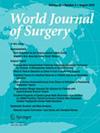A high Ki-67 labeling index and high thyroglobulin doubling rate are significant predictors of excision-site recurrence of papillary thyroid carcinoma following airway resection for locally curative surgery.
IF 2.3
3区 医学
Q2 SURGERY
引用次数: 0
Abstract
BACKGROUND Papillary thyroid carcinoma (PTC) occasionally invades the trachea and requires airway resection. Tracheal excision site recurrence (ESR) is a serious problem. We investigated predictors of ESR in patients with PTC who underwent airway resection for locally curative surgery. METHODS We enrolled 149 patients with PTC who underwent airway resection (median age at the initial surgery: 67 years), including partial-thickness resection (n = 73) or full-thickness resection (n = 76), for grossly curative surgery. The median postoperative follow-up period was 93 months. RESULTS To date, 11 patients (6.7%) underwent ESR: 6 underwent full-thickness resection and 5 underwent partial-thickness resection. The time to ESR ranged from 14 to 113 months (median: 57 months) after the initial surgery. None of the 11 ESR patients underwent adjuvant external beam radiotherapy (EBRT) and none of the 4 airway resection patients who underwent EBRT developed ESR. The 5- and 10-year ESR rates were 4.3% and 11.3%, respectively. In the multivariate analysis (forward-backward stepwise selection method), a Ki-67 labeling index (LI) ≥5% (p = 0.048) and the thyroglobulin doubling rate (Tg-DR) >0.33/year (p = 0.009) (for Tg-antibody negative cases) were independent predictors of ESR. Nine of the 11 patients underwent ESR resection and only one developed a second recurrence. CONCLUSIONS A high Ki-67 LI was a static predictor, and high Tg-DR was a dynamic predictor, of ESR in patients with PTC following airway resection. In such patients, careful postoperative monitoring for ESR is necessary and adjuvant therapies, such as EBRT, may be considered.高Ki-67标记指数和高甲状腺球蛋白倍增率是预测甲状腺乳头状癌气道切除术后切除部位复发的重要指标。
背景甲状腺乳头状癌(PTC)偶尔会侵犯气管,需要进行气道切除。气管切除部位复发(ESR)是一个严重的问题。我们研究了因局部根治性手术而接受气管切除术的 PTC 患者 ESR 的预测因素。方法 我们招募了 149 名接受气管切除术的 PTC 患者(初次手术时的中位年龄:67 岁),包括部分厚度切除术(73 人)或全厚度切除术(76 人),这些患者均接受了根治性手术。结果迄今为止,11 名患者(6.7%)接受了 ESR:6 名接受了全厚切除术,5 名接受了部分厚切除术。首次手术后到 ESR 的时间从 14 个月到 113 个月不等(中位数:57 个月)。11 名 ESR 患者均未接受辅助体外放射治疗 (EBRT),4 名接受 EBRT 的气道切除患者均未发展为 ESR。5年和10年的ESR发生率分别为4.3%和11.3%。在多变量分析(前向后逐步选择法)中,Ki-67标记指数(LI)≥5%(P = 0.048)和甲状腺球蛋白倍增率(Tg-DR)>0.33/年(P = 0.009)(Tg抗体阴性病例)是ESR的独立预测因素。结论高 Ki-67 LI 是气道切除术后 PTC 患者 ESR 的静态预测因子,高 Tg-DR 是 ESR 的动态预测因子。对于这类患者,有必要在术后对 ESR 进行仔细监测,并可考虑 EBRT 等辅助疗法。
本文章由计算机程序翻译,如有差异,请以英文原文为准。
求助全文
约1分钟内获得全文
求助全文
来源期刊

World Journal of Surgery
医学-外科
CiteScore
5.10
自引率
3.80%
发文量
460
审稿时长
3 months
期刊介绍:
World Journal of Surgery is the official publication of the International Society of Surgery/Societe Internationale de Chirurgie (iss-sic.com). Under the editorship of Dr. Julie Ann Sosa, World Journal of Surgery provides an in-depth, international forum for the most authoritative information on major clinical problems in the fields of clinical and experimental surgery, surgical education, and socioeconomic aspects of surgical care. Contributions are reviewed and selected by a group of distinguished surgeons from across the world who make up the Editorial Board.
 求助内容:
求助内容: 应助结果提醒方式:
应助结果提醒方式:


